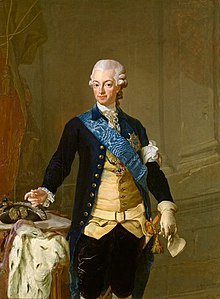| Gustav III | |
|---|---|
 Portrait by Lorens Pasch, 1777 | |
| King of Sweden | |
| Reign | 12 February 1771 – 29 March 1792 |
| Coronation | 29 May 1772 |
| Predecessor | Adolf Frederick |
| Successor | Gustav IV Adolf |
| Born | 24 January 1746 Stockholm, Sweden |
| Died | 29 March 1792 (aged 46) Stockholm Palace, Stockholm, Sweden |
| Burial | 14 May 1792 |
| Spouse | |
| Issue | Gustav IV Adolf Prince Carl Gustav, Duke of Småland |
| House | Holstein-Gottorp |
| Father | Adolf Frederick of Sweden |
| Mother | Louisa Ulrika of Prussia |
| Religion | Lutheranism |
| Signature |  |
Gustav III (24 January [O.S. 13 January] 1746 – 29 March 1792),[a][1] also called Gustavus III,[2] was King of Sweden from 1771 until his assassination in 1792. He was the eldest son of King Adolf Frederick[1] and Queen Louisa Ulrika of Sweden.
Gustav was a vocal opponent of what he saw as the abuse of political privileges seized by the nobility since the death of King Charles XII in the Great Northern War. Seizing power from the government in a coup d'état, called the Swedish Revolution, in 1772, that ended the Age of Liberty, he initiated a campaign to restore a measure of royal autocracy. This was completed by the Union and Security Act of 1789, which swept away most of the powers exercised by the Swedish Riksdag of the estates during the Age of Liberty, but at the same time it opened up the government for all citizens, thereby breaking the privileges of the nobility.
A believer in enlightened absolutism, Gustav spent considerable public funds on cultural ventures, which were controversial among his critics, as well as military attempts to seize Norway with Russian aid, then a series of attempts to re-capture the Swedish Baltic dominions lost during the Great Northern War through the failed war with Russia. Nonetheless, his successful leadership in the Battle of Svensksund averted a complete military defeat and signified that Swedish military might was to be countenanced after its major defeats earlier in the century.[3]
An admirer of Voltaire, Gustav legalised Catholic and Jewish presence in Sweden, and enacted wide-ranging reforms aimed at economic liberalism, social reform and the restriction, in many cases, of torture and capital punishment. The much-praised Freedom of the Press Act of 1766 was severely curtailed, however, by amendments in 1774 and 1792, effectively extinguishing independent media.[4] Following the uprising against the French monarchy in 1789, Gustav pursued an alliance of princes aimed at crushing the insurrection and re-instating his French counterpart, King Louis XVI, offering Swedish military assistance as well as his leadership. In 1792 he was mortally wounded by a gunshot in the lower back during a masquerade ball as part of an aristocratic-parliamentary coup attempt, but managed to assume command and quell the uprising before succumbing to sepsis 13 days later, a period during which he received apologies from many of his political enemies. Gustav's immense powers were placed in the hands of a regency under his brother Prince Carl and Gustaf Adolf Reuterholm until his son and successor Gustav IV Adolf reached adulthood in 1796. The Gustavian autocracy thus survived until 1809, when his son was ousted in another coup d'état, which definitively established parliament as the dominant political power; this has lasted until the modern day, where the Riksdag is Sweden's supreme legislature.[5]
A patron of the arts and benefactor of arts and literature, Gustav founded the Swedish Academy, created a national costume and had the Royal Swedish Opera and Royal Dramatic Theatre built. In 1772 he founded the Royal Order of Vasa to acknowledge and reward those Swedes who had contributed to advances in the fields of agriculture, mining and commerce. He was also a patron of many cultural figures, including Alexander Roslin and Carl Michael Bellman, and is often considered one of the most important figures in the history of Swedish art, music and architecture. Gustav III was well liked by the Swedish population and was mourned upon his death.[6]
In 1777, Gustav III was the first formally neutral head of state in the world to recognise the United States[7] during its war for independence from Great Britain. Swedish military forces were engaged by the thousands on the side of the colonists,[8] largely through the French expedition force.[9] Through the acquisition of Saint Barthélemy in 1784, Gustav enabled the restoration, if symbolic, of Swedish overseas colonies in America, as well as great personal profits from the transatlantic slave trade.[10]
Cite error: There are <ref group=lower-alpha> tags or {{efn}} templates on this page, but the references will not show without a {{reflist|group=lower-alpha}} template or {{notelist}} template (see the help page).
- ^ a b Cite error: The named reference
Britannicawas invoked but never defined (see the help page). - ^ Robert Nisbet Bain: Gustavus III. and his contemporaries 1746–1792, 2 Bände London: Kegan Paul, Trench, Trübner, 1894
- ^ Piper, Grant (4 September 2023). "Brawl In The Baltic Sea: The Battle of Svensksund". Medium. Retrieved 24 October 2023.
- ^ Cronholm, Neander N. (1902). A History of Sweden from the Earliest Times to the Present Day. ch 37
- ^ "Start". www.riksdagen.se (in Swedish). Retrieved 24 October 2023.
- ^ "Gustav III | King of Sweden, Enlightened Ruler, Assassination | Britannica". www.britannica.com. Retrieved 24 October 2023.
- ^ Anna Klerkäng in Sweden – America's First Friend Örebro 1958
- ^ Barton, H.A. (1966). "Sweden and the War of American Independence". The William and Mary Quarterly. 23 (3): 408–430. doi:10.2307/1919238. JSTOR 1919238.
- ^ "Sweden's Part in the American Revolution". Sweden & The American Revolution. By Adolph B. Benson. Illustrated. 216 pp. New Haven: The Tuttle, Morehouse & Taylor Company. The New York Times. 3 July 1927.
- ^ Harrison, Dick (24 September 2016). "Sanningen om det svenska slaveriet (SvD Premium)". Svenska Dagbladet. Retrieved 23 December 2017.